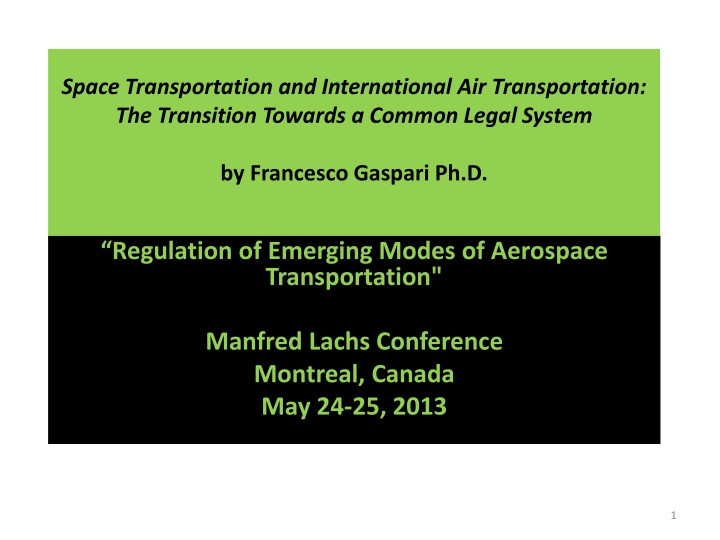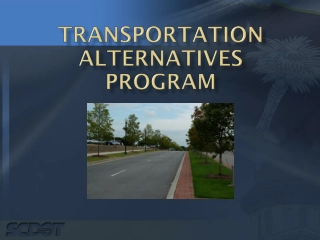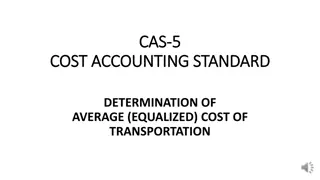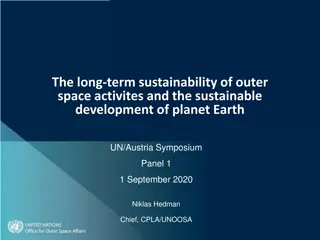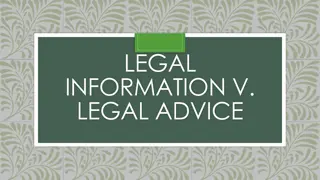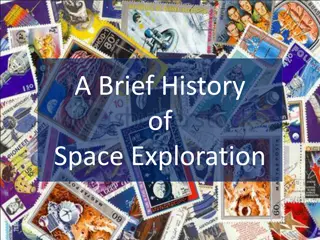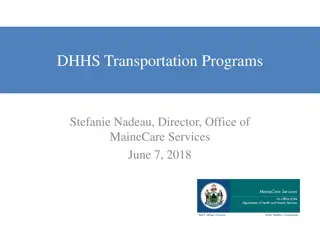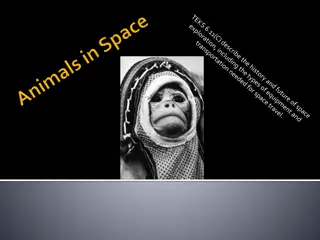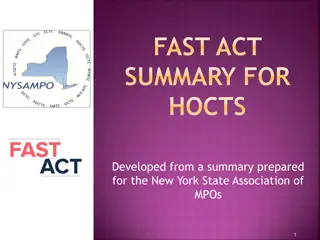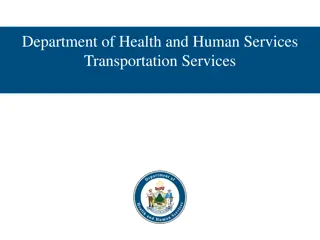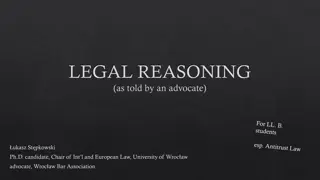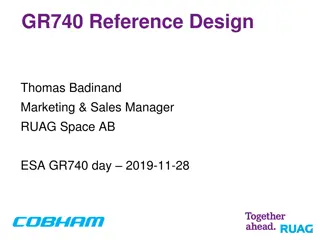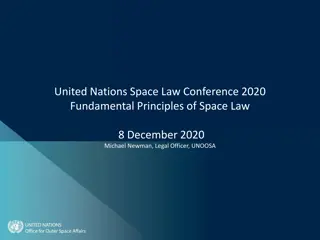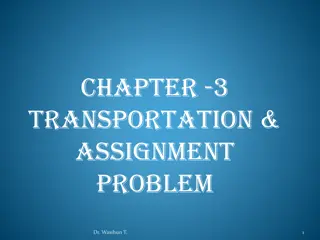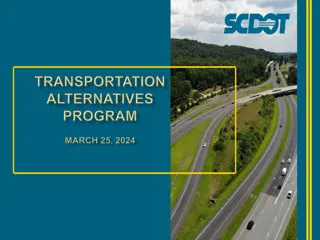Transition Towards a Common Legal System in Space Transportation
International regulations in space and air transportation, the legal regimes governing air law and space law, delimitation between airspace and outer space, lack of codified definitions for airspace and outer space, different theories on demarcation, and the spatial theory.
Download Presentation

Please find below an Image/Link to download the presentation.
The content on the website is provided AS IS for your information and personal use only. It may not be sold, licensed, or shared on other websites without obtaining consent from the author.If you encounter any issues during the download, it is possible that the publisher has removed the file from their server.
You are allowed to download the files provided on this website for personal or commercial use, subject to the condition that they are used lawfully. All files are the property of their respective owners.
The content on the website is provided AS IS for your information and personal use only. It may not be sold, licensed, or shared on other websites without obtaining consent from the author.
E N D
Presentation Transcript
Space Transportation and International Air Transportation: The Transition Towards a Common Legal System by Francesco Gaspari Ph.D. Regulation of Emerging Modes of Aerospace Transportation" Manfred Lachs Conference Montreal, Canada May 24-25, 2013 1
AIR LAW AND SPACE LAW LEGAL REGIMES Air law and space law are currently subject to two different and separate regimes: Air Law 1) the Chicago Convention and its Annexes 2) the Warsaw Convention 3) the Montreal Convention Space Law 1) the Outer Space Treaty 2) the Rescue Agreement 3) the Liability Convention 4) the Registration Convention 5) the Moon Agreement Air Law is basically based on the principle of sovereignty. Space Law is based on the free exploration and use of outer space, and the non appropriation of outer space and the celestial bodies. 2
SUBORBITAL FLIGHTS The applicability of those rules to suborbital flights depends on a preliminary question concerning the scope of application of air law and space law, which in turn is linked to the matter of delimitation between airspace and outer space. The problem of delimitation of the boundary between airspace and outer space is yet far from a common solution. Differences in the legal status of airspace and outer space: There can be no exercise of sovereignty and territorial Jurisdiction. The principle of sovereignty is unrelated to outer space (it can be deduced, a contrario, by reading Article 1 Convention and from the reading of Articles I and II of the Outer Space Treaty and Articles 4 and 11 of the Moon Treaty ). States have exclusive Jurisdiction. The concept of airspace is strictly linked to the principle of sovereignty. of the Chicago 3
THE LACK OF CODIFIED DEFINITIONS OF AIRSPACE AND OUTER SPACE The approaches and theories on the demarcation of the boundary of outer space. Chicago Convention Outer Space Treaty of the airspace from where outer space would begin. None of them contain any indication as regard to any vertical limit COPUOS The issue of definition of outer space has also been discussed within the COPUOS forum since the beginning of The Sixties, but no uncontroversial conclusion has been reached till now. Different approaches or theories on the delimitation of outer space: 1) The Spatial Theory 2) The Functional Theory 3) The International Customary Law Doctrine 4) The No Present Need Theory 4
THE SPATIAL THEORY OR SPATIALISM Spatialism requires that a boundary has to be fixed to determine where airspace ends and where outer space begins. No consensus has been reached so far as to where to draw the line of that demarcation. The legal regime applicable is determined by the location of the object, that is, where the object at issue is (whether it is in airspace, or in outer space, or whether it traverses both). According to this theory, an aerospace vehicle might be considered spacecraft while in space, and an aircraft while in airspace. Drawbacks: The Spatialist approach leads to the application of two different legal regimes to suborbital flights to the same flights. Significant differences exist between air law and space law: as mentioned before, according to Article 1 of the Chicago Convention, aerospace over the territory of a State is subject to its complete and exclusive sovereignty, while Articles 1 and 2 of the Outer Space Treaty prohibit State from exercising any form of territorial sovereignty in space. An aerospace vehicle may enter suborbital space for only a short time, while its primary activity occurs in the airspace. Hence, air law should be applied to the entire movement. Certification problems: aerospace vehicles might be required to be certified under two separate legal regimes (ICAO for air law, and another one for space navigation to be created). 5
THE FUNCTIONAL THEORY OR FUNCTIONALISM According to Functionalism, to determine the applicable regime of law governing the movement should be considered the type of vehicles, that is, whether the movement is operated by an aircraft, or by a spacecraft, or by an aerospace vehicle. No spatial delimitation is needed. To identify the type of vehicle involved, it is generally referred to its purpose, or its activity, or its destination. if the primary purpose of the vehicle is to provide transportation from one point on Earth to another (an Earth-to-Earth mission), the vehicle will be qualified as an aircraft, and air law applies all through the entire flight, irrespective of its location. If the main purpose of the vehicle is to go into outer space to conduct, f.i., outer space activities, the vehicle will be qualified as a space object, and space law applies. The Functional Theory uses also another criterion as to determine what kind of vehicle is at stake, namely, the technical configuration and capabilities of it. Benefits: The functionalist approach presents the advantage that a single legal regime would be applicable throughout the flight. This approach can adequately deal with the problem of the applicable legal regime to suborbital flights, as it is clear that: Air law always applies during the entire journey when a suborbital vehicle merely passes through outer space in the course of Earth-to-Earth transportation. Space law applies during its entire journey when a vehicle passes through airspace in the course of an Earth-to-Space transportation. 6
THE INTERNATIONAL CUSTOMARY LAW DOCTRINE According to this Doctrine, some aspects of the issue have already been solved by an international customary law The content of the customary law The lowest altitude at which a satellite could orbit the Earth, about 100 km above the sea level, is not subject to national sovereignty rights and is governed by space law. According to this view, below 100 km lies airspace, and above 100 km begins outer space. As a consequence, this altitude would represent the boundary between airspace and outer space set up by an international custom. Drawbacks: The existence of such a (numerical) limit regarding the delimitation of outer space is not accepted by most States and scholars. Although the existence of an international customary rule that recognizes that the lowest altitude of orbiting satellite, about 100 km above sea level, belongs to outer space, no international custom recognizing this altitude as the boundary between outer space and airspace has been established. 7
THE NO PRESENT NEED THEORY a delimitation line should be drawn somewhere in Space, (but) the definition of this line is not a priority. Different views have been expressed to support this theory. This view requires that: The boundary scientific with consequence that it has to be left to scientists to solve delimitation The has nature, with the law only rendering the possibility of assisting formulation of a solution demarcation basically issue is Setting a boundary might fetter Space activities or needlessly interfere with the existing regime of international aviation The need for such delimitation is fast growing, but it is not of importance political matter, the crucial in the All these reasons are no longer valid to hinder the delimitation of outer space. Even the scientific and technical data gathered in the past decades are considered to be sufficient to provide an objective basis for the establishment of a specific altitude above sea level as a boundary between air space and outer space. 8
THE EMERGING MODES OF AEROSPACE TRANSPORTATION AND THE NEED FOR A HARMONIZED LEGAL REGIME Aerospace transportation systems will be highly influenced by the legal regime in which they are developed. The regulation of those new modes of transportation may be imagined only within the UN umbrella, as it involves a global dimension. There are (at least) two ways through which the aerospace regulation under the UN could be implemented: by extending the ICAO mandate to aerospace transportation and suborbital flights by creating a new international convention (even under COPUOS) to regulate space vehicles Under the ICAO perspective, two different hypotheses can be made: Although over the last 35 years COPUOS has been drafting guidelines and principles, to date it has been promulgate any multilateral legal instrumentfor ratification by States involved in unable to or amending the existing ICAO Annexes to the Chicago Convention or promulgating a new Annex on Space Standards 9
THE EMERGING MODES OF AEROSPACE TRANSPORTATION AND THE NEED FOR A HARMONIZED LEGAL REGIME The first sub-hypothesis would consist in redefining aircraft to include aerospace vehicles, so that when they fly in the airspace used by civil aircraft, the rules of safety and navigation are the same . That solution requires the amending of the aircraft definition in order to include aerospace vehicles in the scope of the former. Moreover, it has been suggested that ICAO should amend its Annexes to make clear that suborbital vehicles are included in the definition of aircraft. As regard liability, ICAO could ascertain whether the Montreal Convention (1999) provisions as well as the provisions contained in other aviation security conventions are applicable to aerospace vehicles. The second sub-hypothesis would consist in promulgating a new Annex on Space Standards , on the basis of Article 37 of the Chicago Convention. Although this provision lists eleven areas to which ICAO has the authority to promulgate Standards and Recommended Practices as Annexes to the Convention, that list is considered not stringent, as ICAO, since its creation, has focused on other areas not explicitly listed in Article 37. The authority of ICAO as codified in Article 37 is very similar to the Theory of Implied Powers developed by the EU Court of Justice. According to that theory, the EU has powers not only expressly laid down in the Treaty, but also to be implied from express provisions. Within the EU legal order, another extension of competence is set out in Article 352 (Flexibility Clause) of the Treaty on the Functioning of the European Union (TFEU). 10
THE EMERGING MODES OF AEROSPACE TRANSPORTATION AND THE NEED FOR A HARMONIZED LEGAL REGIME However, before promulgating such an Annex, ICAO, by virtue of its global vocation, could launch a survey similar to that recommended by the Air Transport Regulation Panel (ATRP/11) by which States (and other interested parties, admitted to vote at the survey at stake) would be requested to assess the feasibility of a new Annex for the implementation of a global regulatory system in aerospace. The possible reached consensus by responding States (as well as other interested parties) on the core substance of such an Annex would make the enactment of the proposed Annex more pursuable, so as to secure the highest practicable degree of harmonization in regulations, standards, procedures, and organization (Article 37 of the Chicago Convention refers). Waiting for multilateral legal instruments, we believe that the simplest and most viable solution to address the issue in this specific historic phase of transition from air law and space law to aerospace law is to extend the ICAO authority to space law (the first sub- hypothesis above mentioned under the ICAO perspective). 11
THE ICAO ROLE IN THE TRANSITIONAL PHASE AND THE WAY FORWARD Pros and Cons of the ICAO involvement: ICAO as a global forum In that phase, what States need is a global forum to discuss issues related to the emerging modes (aerospace) and an organization that leads the current towards a codification and regulation of a unique aerospace legal regime accepted by all the interested parties (coming from both air law and space law sectors). ICAO safety and security policies As ICAO pointed out, safety (and security) is one of the most important goals in the field of air transport, and it reached irrespective change in economic regulatory arrangements. of transportation has to be of transitional stage any ICAO and harmonization measures Moreover, ICAO would be the proper global forum to deal with the building of the aerospace legal regime for other reasons, such as global regulation and harmonization measures. From this perspective, ICAO represents the proper global forum to deal with those issues, as it is not questionable the importance of the guidance in the field of air transport (at least with respect to flights in the Earth s atmosphere) on issues like safety and security, navigation, liability. ICAO policies and 12
THE ICAO ROLE IN THE TRANSITIONAL PHASE AND THE WAY FORWARD The weakness of that solution (ICAO as a global regulator): SARPs are non binding for States. In particular, SARPs imply a moral obligation for State compliance, the policies are not mandatory; application, implementation or compliance are at the States discretion . However, according to a school of thought, the non binding nature of ICAO SARPs could be overcome: through reading of Articles 12, 37 and 38 of the Chicago Convention, it is assumed that Contracting would be obliged to follow those harmonization measures. the combined by the consideration according to which States that have not notified ICAO of differences between their national regulation and the contents of SARPs bear responsibility for implementing SARPs once they become effective; States 13
CONCLUSIONS De iure condendo, we believe that ICAO could be the proper international Organization, not only to lead this transitional phase from air law and space law to airspace law, but also to regulate the entire aerospace sector in the (near) future. In this regard, ICAO has the authority to both promulgate a new Annex on Space Standards , and amend an existing one. Both those solutions will allow aerospace vehicles to operate under a UN specialized agency and to apply all regulation concerning safety, security, liability, as well as all other relevant rules in a harmonious and well experienced way. Operating within such a single legal regime in aerospace would, also, make possible avoid the increasing of the danger of aircraft and aerospace vehicle collisions, and will attract investments in commercial space transportation systems. In conclusion, we believe that not many bodies could guarantee the fulfillment of those priorities like ICAO is likely to do. 14
THANK YOU VERY MUCH FOR YOUR ATTENTION! Dr Francesco Gaspari, SSPL, PhD, MRAeS Attorney at Law Rome Research Fellow and Adjunct Professor at Universit G. Marconi, Rome Research Fellow at Demetra Research Center, Rome Fellowship Holder at the Italian Space Agency (ASI), Rome International Bar Association (IBA) European Centre for Space Law (ECSL) Royal Aeronautical Society (RAeS) Email: fran.gaspari@libero.it f.gaspari@unimarconi.it 15
